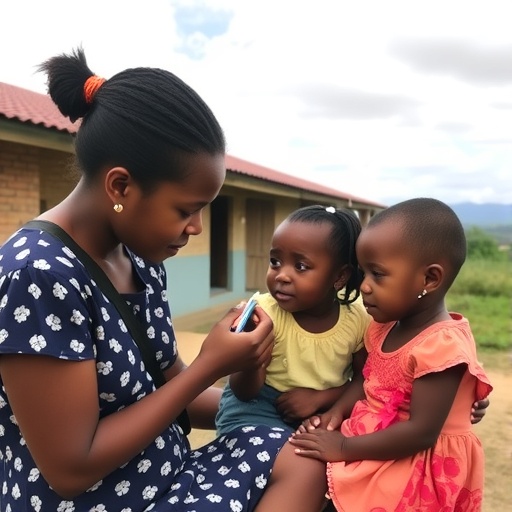In recent years, the concept of telemedicine has undergone a remarkable transformation, becoming an indispensable element of healthcare delivery, especially in resource-limited settings. A recent study conducted by researchers Klarman, Garilus, Cassion, and colleagues explores the pathways to optimize a pediatric telemedicine and medication delivery service in Haiti. This comprehensive investigation sheds light on the intricacies of implementing telehealth solutions, particularly in pediatric care, thereby presenting a blueprint that could be replicated in similar environments across the globe.
Telemedicine is often lauded for its potential to enhance healthcare accessibility and quality, especially in areas that are traditionally underserved. The study aimed to analyze the current landscape of pediatric telemedicine in Haiti, focusing on the challenges and opportunities that exist within this multifaceted realm. Researchers conducted a multi-level qualitative study, gathering insights from healthcare providers, patients, and families to identify the key factors that influence the success of telemedicine initiatives. The findings underscore the necessity of creating an adaptable framework that responds to the unique cultural and logistical challenges inherent in the Haitian healthcare system.
As the study highlights, the integration of telemedicine into the pediatric landscape requires a nuanced understanding of local health needs. Healthcare providers in Haiti face numerous obstacles, from a lack of infrastructure to limited access to digital literacy. The researchers discovered that establishing robust communication channels is essential for ensuring effective delivery of telehealth services. Digital platforms facilitating consultations can only be successful if healthcare workers are adequately trained and supported in using technology. This poses both an opportunity and a challenge, as investing in digital literacy not only enhances telemedicine capabilities but also builds a more competent healthcare workforce.
One pivotal finding of the study suggests that community engagement is a key component of successful telemedicine initiatives. In the context of pediatric care, involving parents and guardians in the telehealth process creates a more holistic approach to treatment. Families are more likely to embrace telemedicine when they understand its benefits and feel a part of their child’s healthcare journey. The study points to the necessity of educational outreach and community workshops to ensure that families are informed and comfortable utilizing telemedicine services. By fostering trust and comprehension, the barriers to telehealth adoption diminish significantly.
Furthermore, the research emphasizes the importance of cultural sensitivity in developing a pediatric telemedicine framework. The Haitian cultural context is intricate and multifaceted, influencing health perceptions and behaviors. Researchers found that telemedicine strategies that respect and incorporate local customs and beliefs are more likely to achieve buy-in from families. This cultural alignment is crucial for ensuring that the services provided resonate with users and result in higher satisfaction and adherence to treatment plans.
In analyzing the technological landscape, the study reveals that internet connectivity remains a significant barrier to accessing telemedicine in Haiti. While mobile technology is increasingly prevalent, inconsistent internet access can hinder the efficacy of virtual consultations. The researchers propose that partnerships with telecommunications providers could aid in bridging this gap. Initiatives that provide subsidized internet access for healthcare facilities or promote community-supported Wi-Fi hotspots could elevate the feasibility of telemedicine for pediatric patients across various regions.
As the researchers delved deeper into the logistics of medication delivery alongside telemedicine, they uncovered a critical intersection between virtual consultations and on-the-ground medicinal supply chains. The timely delivery of medicines is paramount for effective pediatric care, yet many families face challenges in accessing necessary medications. The study advocates for integrated systems that pair telemedicine consultations with local pharmacies and delivery services. By creating a cohesive network that simplifies the procurement of medications, healthcare providers can ensure continuity of care for their pediatric patients.
The potential for telemedicine to alleviate healthcare disparities in Haiti cannot be understated. The study’s findings resonate with a global audience, as many regions grapple with similar issues pertaining to healthcare accessibility. The lessons learned from the Haitian context can serve as a foundational groundwork for other nations striving to enhance their telehealth initiatives. Moreover, the success of such programs could set a precedent, encouraging further investment in telemedicine solutions worldwide, particularly in low-resource settings.
A significant aspect presented in the research pertains to the evaluation of telemedicine programs. Establishing metrics for success is paramount in assessing the impact of telehealth services on pediatric care. The researchers recommend the implementation of comprehensive evaluation frameworks that include patient outcomes, satisfaction rates, and accessibility metrics. By continuously monitoring and refining telemedicine operations, stakeholders can ensure that services evolve in line with user needs and technological advancements.
In conclusion, the study conducted by Klarman, Garilus, Cassion, and colleagues serves as a clarion call for the development and optimization of pediatric telemedicine in Haiti. Through a meticulous analysis of multi-level qualitative data, the researchers illustrate the critical pathways to improving telehealth services. Addressing barriers such as digital literacy, community engagement, cultural sensitivity, and logistical challenges underscores the intricate balance required to elevate healthcare delivery in underserved populations.
The implications of this study extend beyond Haiti; they resonate within the global discourse on healthcare equity and access. As nations continue to grapple with the implications of technological advancements in healthcare, the lessons derived from this research offer a thoughtful and practical approach to harnessing the potential of telemedicine. By leveraging local insights and building robust, culturally sensitive frameworks, healthcare providers can pave the way for a healthier future for children— both in Haiti and around the world.
Subject of Research: Pediatric telemedicine and medication delivery service optimization in Haiti.
Article Title: Pathways to optimize a pediatric telemedicine and medication delivery service: a multi-level qualitative study in Haiti.
Article References: Klarman, M.B., Garilus, F.E., Cassion, K. et al. Pathways to optimize a pediatric telemedicine and medication delivery service: a multi-level qualitative study in Haiti. BMC Health Serv Res 25, 1379 (2025). https://doi.org/10.1186/s12913-025-13514-x
Image Credits: AI Generated
DOI:
Keywords: Telemedicine, Pediatric care, Haiti, Healthcare accessibility, Medication delivery, Community engagement, Digital literacy, Cultural sensitivity.




